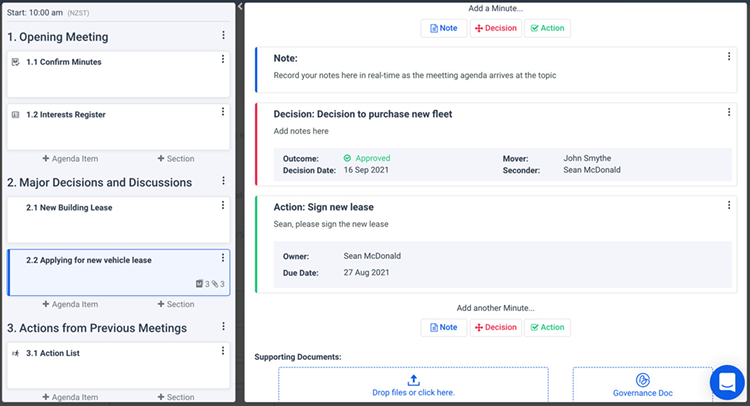Why board meeting minutes really matter
While minutes often prompt in-jokes about board performance (for example, ‘boards take minutes and waste hours’), they are no laughing matter. Board meetings are an essential component of an organisation’s decision-making process. For various reasons, the quality of the board meeting minutes and the protection of their integrity, once approved must be treated with considerable gravity. Boards should pay closer attention to both the recording and approval of their minutes than is often the case.
Why should you care about the quality of your minutes?
- To be legally compliant
- Integrity of the process
- Organisation and director reputation
- Decision evaluations and reviews
- Clarify responsibilities and take action
- Facilitate due diligence
- A record of the organisations history
What should be included in the minutes
Top tips for boardrooms
Essential components of minutes
How BoardPro solves the minute taking conundrum
1. To be legally compliant
It is a widespread legal requirement for incorporated bodies to keep a written record of their board meeting minutes and decisions. This requirement applies whether decisions are taken at a properly convened meeting or ‘between meetings’ by way of Flying Minutes. Failure to keep an adequate record of its proceedings might be taken as a worrying sign not only of the board’s competence but of its integrity. Inadequate minutes may also compromise some aspects of a corporate entity’s legal protections.
2. To demonstrate the integrity of process
Minutes are a record of important organisational transactions. While an enduring record of its deliberations is primarily for the benefit of the board itself, minutes are also increasingly important to third parties. When minutes are described as ‘a letter to a judge’, it acknowledges their importance in special inquiries or litigation when board decisions (or a lack of them) are under the microscope. Minutes are the ‘paper trail’ that can help prove that proper authority was exercised, and correct procedure was followed.
The process of approving minutes is as important as what is written in them. That is why after minutes have been approved by the board as a true and correct record, they should not be altered. If there is subsequent disagreement with a decision, and the board has second thoughts, it is not the minute book that should be changed, but the decision - at the next meeting. Typically, in a legal contest the other side has to prove that a board’s minutes are not correct. For example, in a dispute about whether a board acted in compliance with applicable legal and contractual requirements, the courts will accept the board’s minutes as the best record of its decision and the basis on which it was made. But, if that record is inadequate - for example, it is too cryptic - the board may be faced with a judicial conclusion that it had not properly decided the matter.
3. To protect organisational and director reputation
Boards frequently have to deal with potential conflicts of interest. Handling these with care is essential to protecting the reputation and the integrity of the organisation and individual directors who may later be vulnerable to accusations that they have misused their positions. Minutes should accurately and thoroughly record the process taken (e.g., full disclosure of the actual or potential conflict and the extent to which a potentially conflicted director is involved, if at all, in the decision making process).
4. As a basis for decision evaluation and review
Historically, popular advice was to keep the minutes to a brief record of decisions only - so that a board’s decision making process was not exposed. Current thinking is the complete opposite - that the best defence for a board whose decisions are questioned is to have documented the diligence and thoroughness that was applied. Boards need to be able to demonstrate that they received sufficient information and advice from reasonable sources, that such information and advice was properly interrogated, and that appropriate discussion occurred before the board made its final choice.
Minutes that record the thinking on which a decision was based, are also an important starting point for the board’s own post-decision evaluations. If, for example, a project the board approved did not meet expectations, were there flaws in the original decision making process or its subsequent implementation oversight that they could learn from?
Because board and executive team members change over time, minutes are also important when current board and management teams want to understand why, for example, a longstanding policy which now has no apparent purpose, was adopted. They should expect to be able to find information on the objectives, and the assumptions on which the policy was originally based, in past minutes and attached papers.
5. To clarify responsibility and track actions
The content of board minutes frequently contain details of the assignment of responsibility for further action on a variety of the matters that were discussed. Whether this assignment is to members of the board, or to the chief executive, documenting accountability in the minutes creates an implementation tracking reference point. For greater visibility and easier access, this kind of content is often copied into a separate action list. Nevertheless, the starting point is what was recorded in the minutes.
6. To facilitate due diligence
Auditors have an obvious interest in a board’s minutes, but board records are also an important source of information for others who may be entitled to access these records. For example, directors considering joining the board would want to know about potential risks and liabilities. Similarly, board minutes play an important part in the induction of new directors and senior executives. Minutes often hold the key to a new director’s or a new chief executive’s understanding of the origins of current issues and even pointers to future challenges.
In a sales process a prospective purchaser, and in a merger situation a potential partner may have similar interest. If it turns out there are significant errors or omissions, or if the minutes are misleading, it may lead to trouble for those who approved the original minutes.
7. As a record of an organisation’s history
We should also acknowledge the broader value of minutes in terms of historical research. Most organisational histories are written with extensive reliance on the minutes of past board meetings. As board minutes are recorded so is an organisation’s longer-term history being recorded.
What should be included in the minutes?
- The title of the meeting (e.g., board or committee)
- Date and time (including the time the meeting concluded)
- Venue and place
- Participation: noting who were the decision makers (e.g., directors) and confirm that a quorum existed. Noting also who were also ‘in attendance’ (staff, external advisors, observers, visitors, etc.) and those with specific roles in relation to the conduct of the meeting (e.g., chair, secretary/minute taker). Apologies should be recorded as well as no-shows being noted. Any changes in attendance during the meeting should also be acknowledged (e.g., when a director leaves the room and returns).
- Meeting description (what business was dealt with and in what order, how it was handled (procedure, discussion, votes, etc.) and with what result (decisions).
As indicated previously, the minutes are not only a record of a board’s decisions but of the development of the board’s thinking about significant topics. Generally, minutes should aim to achieve a ‘Goldilocks’ kind of balance. They should be neither too long nor too short - but the more important something is, the more thorough, and likely extensive the minutes should be. A good test of any decision described in the minutes is whether someone who was not present can later see how and why the board arrived at its final position. Material that is influential in the board’s decisions on matters of substance should normally be included by reference.
Minutes should also record that appropriate governance processes were observed. Minutes that record the steps taken encourage a higher level of compliance with agreed decision-making processes and protects both the board and an organisation’s stakeholders. If normally part of a board’s operating mode, parliamentary-style procedural motions and voting outcomes should be applied and accurately recorded, including votes in opposition to a motion and abstentions.
Usually, it is neither necessary nor advisable to note who said what. Directors are collectively accountable for a board’s final decisions whether those reflect their personal preferences or not. In reaching decisions, members must be able to contribute to rigorous and meaningful discussions.
While ultimately a director’s personal view on a matter is not relevant, individual views can be heard and acknowledged without attribution. For example: “When considering the proposal, the board reflected on a concern that the cash flow needed to fund the initiative might be insufficient if there was a further COVID-related lockdown. On balance, however, it felt that its present and prospective reserves would be sufficient to carry it through.”
Top tips from real boardrooms
We teamed up with our researchers to ask 64 participants (board members, CEOs and board administrators) for their advice on a number of issues pertaining to board minute taking.
“Prepare a draft outline after the papers have been distributed and before the meeting. Always prepare minutes within 24 hours after the meeting. Record that the Board discussed (never noted) and that they considered the risks and opportunities”
In an ideal world every board would have a competent scribe assigned the task of taking the minutes. Someone who is not required to participate in the meeting but who understands the business and has solid experience of governance. However, this is not always the case. In smaller and less well-resourced organisations the task may by default fall to a board member, or a member of the management team.
Minutes should be clearly written, balanced, impartial, and most importantly - accurate. If just one set of minutes is wrong, it throws doubt upon any other minutes that the board may later need to rely on. No matter who has prepared the minutes, particular care needs to be taken in reviewing the first draft. One risk, if the draft minutes have been prepared by anyone who has participated in the meeting, is the temptation to write up the meeting as they thought it should have occurred rather than as it did.
Generally, the initial review (and, if necessary, correction) of draft minutes should be undertaken by the board chair. Then the draft should be sent to all directors asking them to identify any discrepancies or errors. It is an opportunity for them to compare against any notes they may have made themselves during the meeting.
The final step is for the minutes to be formally confirmed by the board as a true and correct record. They now form part of the official record for the organisation.
Typically the approval of the minutes has been one of the first items on a board's meeting agenda, but this is not a necessity at the top of the agenda unless subsequent items cannot be dealt with until the minutes are confirmed.
It is important to note that the chair is involved at each step in the confirmation of minutes. It is a core part of the chair’s role as board leader to protect the integrity of the record of the board’s deliberations whether or not the minutes have been written by skilled, highly qualified minute taker. Remember that the minutes are the board’s record of the board’s meeting.
“When you prepare minutes, remember that your goal is not to provide a transcript of the conversation but instead to clearly document what decisions were made and the overall summary of the conversation that led to a particular decision. During a meeting, write as many notes as you like but then ask yourself - what were the key moments/questions in the conversation and what was the final decision or outcome from the conversation”

C.Dir, Governance Guys.
Essential components of meeting minutes
Jardine also said, "Your minutes should complement the meeting’s agenda. The agenda should be the framework for your minutes. In some ways the agenda provides the outline for the minutes and the minutes provide the evidence that not only was the agenda followed but the key outcomes for the meeting were met."
“Make sure that decisions, questions, answers and actions are clearly recorded for future reference . If you can, hire a professional to take minutes. It means that the CEO and directors can focus on the meeting, not on the minutes”

CEO, BIO Gro NZ.
How BoardPro solves the minute taking conundrum
BoardPro Minute Taking enables the board administrator or company secretary to take clear and precise minutes against the agenda topics as they arrive in the meeting agenda. The most important part of the meeting is made easy with accurate and timely minutes with BoardPro Minute Taking. Capture meeting topic notes, decisions and actions, and see it all turned into a professional document to send to your board.
BoardPro minutes - Decisions - Actions
Share this
You May Also Like
These Related Stories

Board meeting minutes - 7 key factors for success

How to create quality meeting minutes




